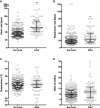Prognostic Value and Development of a Scoring System in Horses With Systemic Inflammatory Response Syndrome
- PMID: 28207163
- PMCID: PMC5354005
- DOI: 10.1111/jvim.14670
Prognostic Value and Development of a Scoring System in Horses With Systemic Inflammatory Response Syndrome
Abstract
Background: Despite its widespread use in equine medicine, the clinical value of the systemic inflammatory response syndrome (SIRS) concept in horses remains unknown.
Objectives: To study the prognostic value of measures of SIRS in horses and identify the best model of severe SIRS to predict outcome.
Animals: A total of 479 consecutive adult horse emergency admissions to a private primary referral practice.
Methods: Prospective observational study. All adult horses admitted for emergency treatment over the study period were included. Multivariate logistic regression and stepwise model selection were used.
Results: Each of the 4 SIRS criteria was associated with outcome in this population. Thirty-one percent of emergency cases had 2 or more abnormal SIRS criteria on admission and were defined as SIRS cases. SIRS was associated with increased odds of death (odds ratio [OR] = 8.22; 95% CI, 4.61-15.18; P < .001), an effect mainly found for acute gastrointestinal cases. SIRS cases were assigned a SIRS score of 2, 3, or 4, according to the number of abnormal SIRS criteria fulfilled on admission, and SIRS3 and SIRS4 cases had increased odds of death compared to SIRS2 cases (OR = 4.45; 95% CI, 1.78-11.15; P = .002). A model of severe SIRS including the SIRS score, blood lactate concentration, and color of the mucous membranes best predicted outcome in this population of horses.
Conclusions and clinical importance: Systemic inflammatory response syndrome is associated with an increased risk of death in adult horses presenting with acute gastrointestinal illnesses. The model of severe SIRS proposed in this study could be used to assess the status and prognosis of adult equine emergency admissions.
Keywords: Equine; Lactate; Mucous membranes; Outcome.
Copyright © 2017 The Authors. Journal of Veterinary Internal Medicine published by Wiley Periodicals, Inc. on behalf of the American College of Veterinary Internal Medicine.
Figures




Similar articles
-
Association of Presence of Band Cells and Toxic Neutrophils with Systemic Inflammatory Response Syndrome and Outcome in Horses with Acute Disease.J Vet Intern Med. 2016 Jul;30(4):1284-92. doi: 10.1111/jvim.13968. Epub 2016 May 23. J Vet Intern Med. 2016. PMID: 27214343 Free PMC article.
-
Cortisol and adrenocorticotropic hormone concentrations in horses with systemic inflammatory response syndrome.J Vet Intern Med. 2019 Sep;33(5):2257-2266. doi: 10.1111/jvim.15620. Epub 2019 Sep 12. J Vet Intern Med. 2019. PMID: 31512777 Free PMC article.
-
Plasma iron concentrations and systemic inflammatory response syndrome in neonatal foals.J Vet Intern Med. 2020 May;34(3):1325-1331. doi: 10.1111/jvim.15770. Epub 2020 Apr 16. J Vet Intern Med. 2020. PMID: 32297679 Free PMC article.
-
Defining the Systemic Inflammatory Response Syndrome in Equine Neonates.Vet Clin North Am Equine Pract. 2015 Dec;31(3):463-81. doi: 10.1016/j.cveq.2015.08.001. Vet Clin North Am Equine Pract. 2015. PMID: 26612743 Review.
-
Scoring System for Multiple Organ Dysfunction in Adult Horses with Acute Surgical Gastrointestinal Disease.J Vet Intern Med. 2016 Jul;30(4):1276-83. doi: 10.1111/jvim.14321. Epub 2016 Jun 14. J Vet Intern Med. 2016. PMID: 27296454 Free PMC article. Review.
Cited by
-
The Usefulness of Mesenchymal Stem Cells beyond the Musculoskeletal System in Horses.Animals (Basel). 2021 Mar 25;11(4):931. doi: 10.3390/ani11040931. Animals (Basel). 2021. PMID: 33805967 Free PMC article. Review.
-
Prognostic value of colonic and peripheral venous lactate measurements in horses with large colon volvulus.Vet Surg. 2020 Apr;49(3):472-479. doi: 10.1111/vsu.13361. Epub 2020 Jan 9. Vet Surg. 2020. PMID: 31916608 Free PMC article.
-
Plasma-Ionized Magnesium in Hospitalized Horses with Gastrointestinal Disorders and Systemic Inflammatory Response Syndrome.Animals (Basel). 2022 Jun 7;12(12):1479. doi: 10.3390/ani12121479. Animals (Basel). 2022. PMID: 35739816 Free PMC article.
-
A Comparative Review of Equine SIRS, Sepsis, and Neutrophils.Front Vet Sci. 2019 Mar 12;6:69. doi: 10.3389/fvets.2019.00069. eCollection 2019. Front Vet Sci. 2019. PMID: 30931316 Free PMC article. Review.
-
Do plasma protein:fibrinogen ratios in horses provide additional information compared with fibrinogen concentration alone?Can Vet J. 2019 Jun;60(6):625-629. Can Vet J. 2019. PMID: 31156263 Free PMC article.
References
-
- Bone RC, Balk RA, Cerra FB, et al. Definitions for sepsis and organ failure and guidelines for the use of innovative therapies in sepsis. The ACCP/SCCM Consensus Conference Committee. American College of Chest Physicians/Society of Critical Care Medicine. Chest 1992;101:1644–1655. - PubMed
-
- Vincent JL. Dear SIRS, I'm sorry to say that I don't like you. Crit Care Med 1997;25:372–374. - PubMed
-
- MacCallum NS, Finney SJ, Gordon SE, et al. Modified criteria for the systemic inflammatory response syndrome improves their utility following cardiac surgery. Chest 2014;145:1197–1203. - PubMed
-
- Talmor M, Hydo L, Barie PS. Relationship of systemic inflammatory response syndrome to organ dysfunction, length of stay, and mortality in critical surgical illness: Effect of intensive care unit resuscitation. Arch Surg 1999;134:81–87. - PubMed
MeSH terms
Substances
LinkOut - more resources
Full Text Sources
Other Literature Sources

